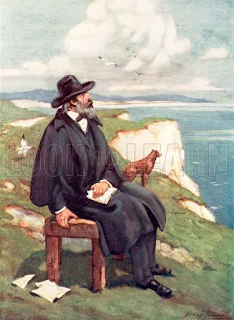Tales of Farringford on The Isle of Wight Home of Alfred Lord Tennyson
Farringford
Tennyson first came to the Isle of Wight in 1846 with Edward Moxon to visit James White of Bonchurch.
On that occasion he rowed around the Needles, and found the view unforgettable. He returned to the island in 1849, and again in 1853 when he was on the lookout for a house. He heard of Farringford, and fell in love with the view from the drawing room, which persuaded him to make Farringford his home. He summoned his wife Emily from Twickenham. Her diary records her impressions of that fateful trip to see Farringford for the first time:
'The railway did not go further than Brockhurst then and the steamer, when there was one, from Lymington felt itself in no way bound to wait for the omnibus which brought as many of the passengers as it could from the train. We crossed in a rowing boat. It was a still November evening. One dark heron flew over the Solent backed by a daffodil sky... Next day we went to Farringford and looking from the drawing-room window I thought "I must have that view," and I said so to him when alone.' Tennyson himself said 'we will go no further, this must be our home.'
On 11 November, 1853, Tennyson agreed to rent Farringford, furnished, on a three-year lease for £2 a week. The lease came with an option to buy. On 25 November Alfred and Emily moved in and their staff which consisted of a housekeeper, butler, cook, page, lady's maid, parlour and kitchen maids, gardeners, grooms and a coachman. In March 1854 their second son, Lionel, was born in Farringford.
By 1856 Alfred Lord Tennyson's income from his writings was over £2,000 a year and he bought the house, park and farmland of Farringford for £6,900. During his time at Farringford he wrote many of his most famous works, including The Charge of the Light Brigade and Maud, while another, Crossing The Bar, was written on a voyage between the mainland and his home.
On 13 May, 1856, on the arrival of Tennyson's own furniture, pictures, boxes of books and other assorted ornaments and antiquities, Prince Albert called. Tennyson, flustered in the middle of arranging the unpacking, is reported to have forgotten to offer Prince Albert a chair. Despite this, Albert remained standing, talking pleasantly, and took a bunch of cowslips home for the Queen. Tennyson did not meet Queen Victoria herself until April 1863. Queen Victoria's diary described the event as follows: 'I went down to see Tennyson who is very peculiar-looking, tall, dark.'
Alfred Tennyson is reported to have been so emotional at the event that his eyes were filled with tears and he could not stand still. He was also unable to remember the Queen's words, and wrote 'I only remember what I said to the Queen - big fool that I was... Why, what an excellent king Prince Albert would have made.' Queen Victoria however was impressed and asked Tennyson to return and bring his family with him. Hallam Tennyson, then ten, wrote 'Observations: You must always say 'mam' when in Her Majesty's presence. You must stand until the Queen asks you to sit down. Her Majesty does not often tell you to sit down...'
From April 1862, Queen Victoria summoned him to court several times. In 1883 he finally accepted his barony title on Queen Victoria's insistence, having declined the invitation from Prime Ministers Disraeli and Gladstone. He became First Baron Tennyson of Aldworth And Freshwater, and first took his seat in the House of Lords in March 1884. Alfred, Lord Tennyson died on 6 October, 1892 at the age of 83 and is buried in Westminster Abbey.
Haunted Farringford
Few buildings of such historic age and importance escape tales of ghosts and hauntings, and Farringford is no exception. Perhaps through being a hotel, where guests are able to stay overnight within its haunted rooms, the chances of visitors to the site coming across something other-worldly are increased. Or perhaps its inspiring views and gothic appearance encourages the imaginations of those who sleep there to run wild in flights of frightening fancy. Perhaps we will never know for certain, but one thing we do know are the tales that those who stay there have told.
Alfred Tennyson, Wife Emily, and two children walking the grounds of Farringford
Chief among the tales of Haunted Farringford are those of Emily Tennyson, who is said to have loved life at Farringford so much that she remains there to this day. She is said to haunt the hotel bedroom that was her nursery, looking after and watching any children that stay, and rocking an invisible cradle.
Emily Tennyson is also supposed to have been seen walking on the lawn, and Alfred Lord Tennyson himself has been reported to have been seen smoking a pipe and relaxing in a chair in the library as well as walking on Tennyson Down, the nearby hill named after him.
Tennyson. Illustration from Cassell's Book of Knowledge (c 1910) by Dudley Tennant.
There are also tales of a phantom horse-drawn carriage seen around the grounds and the road outside Farringford...
Please feel free to leave any comments,





Comments
I love Tennyson's poems, especially Maude. I never knew where he lived or much about his family. Love This!
Yes, I too love Tennyson, who doesn't! He had such an interesting life and the Isle of Wight is breathtakingly beautiful!
Hi gigigirl, as always, you are so kind. Thanks for taking the time to comment!
I'll do some research and see what I can find! Sounds intriguing!
Thanks for commenting!